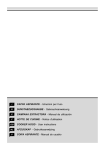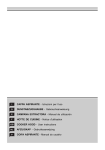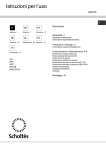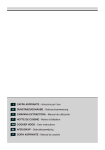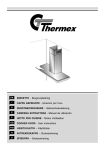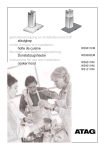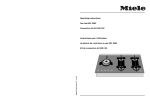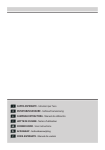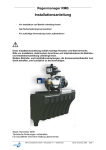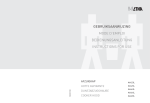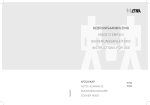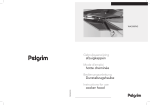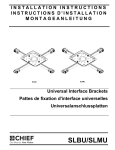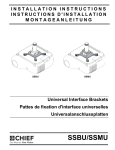Download Elitair PN-36 User's Manual
Transcript
I CAPPA ASPIRANTE - Istruzioni per l'uso D DUNSTABZUGSHAUBE - Gebrauchsanweisung E CAMPANA EXTRACTORA - Manual de utilización F HOTTE DE CUISINE - Notice d'utilisation GB COOKER HOOD - User instructions NL AFZUIGKAP - Gebruiksaanwijzing P COIFA ASPIRANTE - Manual do usuário -2- 445 190 350 224 45 355 505 : 950 150 E C 45 F M A D S 505 523 B 150 P Fig.1 Fig.3 115 32 G Z E F H 490 F 20 25 90° 100 150 L C 25 P 67 B A G Fig.2 Fig.4 -3- -4- ITALIANO GENERALITA' Leggere attentamente il contenuto del presente libretto in quanto fornisce importanti indicazioni riguardanti la sicurezza di installazione, d'uso e di manutenzione. Conservare il libretto per ogni ulteriore consultazione. L'apparecchio è stato progettato per uso in versione aspirante (evacuazione aria all'esterno ), filtrante (riciclo aria all'interno) AVVERTENZE PER LA SICUREZZA 1. Fare attenzione se funzionano contemporaneamente una cappa aspirante e un bruciatore o un focolare dipendenti dall'aria dell'ambiente ed alimentati da un'energia diversa da quella elettrica, in quanto la cappa aspirando toglie all'ambiente l'aria di cui il bruciatore o il focolare necessita per la combustione. La pressione negativa nel locale non deve superare i 4 Pa (4x10-5 bar). Per un funzionamento sicuro, provvedere quindi ad un'opportuna ventilazione del locale. Per l'evacuazione esterna attenersi alle disposizioni vigenti nel vostro paese. 2. ATTENZIONE ! In determinate circostanze gli elettrodomestici possono essere pericolosi. A) Non cercare di controllare i filtri con la cappa in funzione B) Non toccare le lampade dopo un uso protratto dell'apparecchio C) E' vietato cuocere cibi alla fiamma sotto la cappa D) Evitare la fiamma libera, perchè dannosa per i filtri e pericolosa per gli incendi E) Controllare costantemente i cibi fritti per evitare che l'olio surriscaldato prenda fuoco F) Prima di effettuare qualsiasi manutenzione, disinserire la cappa dalla rete elettrica. ISTRUZIONI PER L'INSTALLAZIONE • Collegamento elettrico L'apparecchio è costruito in classe II, perciò nessun cavo deve essere collegato alla presa di terra. L'allacciamento alla rete elettrica deve essere eseguito come segue: MARRONE = L linea BLU = N neutro Se non prevista, montare sul cavo una spina normalizzata per il carico indicato nella etichetta caratteristiche. Se provvista di spina, fare in modo che sia facilmente accessibile dopo l’installazione dell’apparecchio. Nel caso di collegamento diretto alla rete elettrica è necessario interporre tra l'apparecchio e la rete un interruttore onnipolare con apertura minima tra i contatti 3 mm, dimensionato al carico e rispondente alle norme vigenti. • L'apparecchio deve essere installato ad un'altezza minima di 650mm dai fornelli. I Se dovesse essere usato un tubo di connessione composto di due o più parti, la parte superiore deve essere all'esterno di quella inferiore. Non collegare lo scarico della cappa ad un condotto in cui circoli aria calda o utilizzato per evacuare fumi degli apparecchi alimentati da un'energia diversa da quella elettrica. • MONTAGGIO DELLA CAPPA NELLA PARTE INFERIORE DI UN PENSILE Eseguire 4 fori diametro mm. 6 nel fondo del pensile come illustrato nel disegno fig. 3. Montare la cappa sotto il pensile con 4 viti idonee al tipo di mobile. L’ apparecchio è provvisto di 2 uscite dell’ aria, una situata nella parte superiore e l’ altra nella parte posteriore utilizzabili a secondo delle vostre esigenze. Sono forniti a corredo un anello di raccordo (C), al quale collegare il tubo di connessione, ed un tappo (A) per chiudere l’ uscita dell’ aria non utilizzata. • MONTAGGIO DELLA CAPPA ALLA PARETE Eseguire 4 fori (B-P) rispettando le quote indicate in fig. 2. Per i vari montaggi utilizzare viti e tasselli ad espansione idonei al tipo di muro (es. cemento, cartongesso ecc.) Appendere la cappa alla parete utilizzando i 2 fori (B) fig.2. Fissare definitivamente la cappa alla parete utilizzando i due fori di sicurezza inferiori (P). • MONTAGGIO TUBI RACCORDO (OPTIONAL) Eseguire 4 fori (G-H) rispettando le quote indicate in fig. 2. Per i vari montaggi utilizzare viti e tasselli idonei al tipo di muro (es. cemento, cartongesso ecc.). Bloccare la staffa (Z) alla parete fig. 2. Posizionare i due raccordi verticalmente sulla cappa. Appendere il raccordo (F) utilizzando i 2 fori (H) fig. 2. Sfilare il raccordo (E) dal raccordo (F) e bloccarlo lateralmente alla staffa (Z) con le apposite viti. • MONTAGGIO VETRO VELETTA (OPTIONAL) Posizionare il vetro veletta completo di supporti (V) come indicato in fig. 1, e fissare alla cappa con le apposite viti. • MONTAGGIO MANIGLIA (OPTIONAL) Posizionare La maniglia (M) ed i due supporti destro (D) e sinistro (S), come indicato in fig. 1, e fissare alla cappa con le apposite viti. • TRASFORMAZIONE DA CAPPA ASPIRANTE A CAPPA FILTRANTE Per effettuare questa trasformazione (possibile anche dopo l’ uso con sistema aspirante), richiedere al fornitore, se non forniti, una serie di filtri al carbone attivo. I filtri al carbone attivo servono per depurare l’ aria che verrà rimessa nell’ ambiente attraverso i fori posti nella parte anteriore della cappa. I filtri non sono lavabili o rigenerabili e devono essere sostituiti ogni 4 mesi al massimo. La saturazione del carbone attivo dipende dall’ uso più o -5- meno prolungato della cappa, dal tipo di cucina e dalla regolarità con cui viene effettuata la pulizia del filtro grassi. Il filtro (C) deve essere applicato al gruppo aspirante posto all’ interno della cappa centrandolo ad esso e ruotandolo di 90 gradi fino allo scatto d’ arresto. Per questa operazione rimuovere la griglia (G). Chiudere con gli appositi tappi l’ apertura superiore e posteriore di uscita dell’ aria; ruotare la levetta (L) dalla posizione (A) alla posizione (F). La cappa è così disposta per il funzionamento filtrante. USO E MANUTENZIONE • Si raccomanda di mettere in funzione l'apparecchio prima di procedere alla cottura di un qualsiasi alimento. Si raccamanda di lasciar funzionare l'apparecchio per 15 minuti dopo aver terminato la cottura dei cibi, per un'evacuazione completa dell'aria viziata. Il buon funzionamento della cappa è condizionato da una corretta e costante manutenzione; una particolare attenzione deve essere data al filtro antigrasso e al filtro al carbone attivo. • Il filtro antigrasso ha il compito di trattenere le particelle grasse in sospensione nell’aria, pertanto è soggetto ad intasarsi in tempi variabili relativamente all’uso dell’apparecchio. Il filtro acrilico, che si trova appoggiato alla griglia, va sostituito quando le scritte, visibili attraverso la griglia, cambiano colore e l'inchiostro si espande; il nuovo filtro deve essere applicato in modo tale che le scritte siano visibili attraverso la griglia dall'esterno della cappa. Nel caso in cui i filtri acrilici non abbiano le scritte, oppure siano presenti filtri metallici o a pannello in alluminio, per prevenire il pericolo di eventuali incendi, al massimo ogni 2 mesi è necessario lavare i filtri eseguendo le seguenti operazioni: - togliere il filtro dalla griglia e lavarlo con una soluzione di acqua e detergente liquido neutro lasciando rinvenire lo sporco. - Sciacquare abbondantemente con acqua tiepida e lasciare asciugare. I filtri metallici e/o pannello in alluminio possono essere lavati anche in lavastoviglie. Dopo alcuni lavaggi, se i filtri sono in alluminio o pannello in alluminio, si possono verificare delle alterazioni del colore. Questo fatto non dà diritto a reclamo per l'eventuale loro sostituzione. In caso di inadempienza delle istruzioni di sostituzione e di lavaggio si può verificare il rischio di incendio dei filtri antigrasso. • I filtri al carbone attivo servono per depurare l'aria che viene rimessa nell'ambiente. I filtri non sono lavabili o rigenerabili e devono essere sostituiti ogni quattro mesi al massimo. La saturazione del carbone attivo dipende dall'uso più o meno prolungato dell'apparecchio, dal tipo di cucina e dalla regolarità con cui viene effettuata la pulizia del filtro antigrasso • Pulire frequentemente tutti i depositi sul ventilatore e sulle altre superfici, usando un panno inumidito con alcool denaturato o detersivi liquidi neutri non abrasivi. SI DECLINA OGNI RESPONSABILITA' PER EVENTUALI DANNI PROVOCATI DALLA INOSSERVANZA DELLE SUDDETTE AVVERTENZE -6- ENGLISH GENERAL Carefully read the following important information regarding installation safety and maintenance. Keep this information booklet accessible for further consultations. The appliance has been designed for use in the ducting version (air exhaust to the outside), filtering version (air circulation on the inside). SAFETY PRECAUTION 1. Take care when the cooker hood is operating simultaneously with an open fireplace or burner that depend on the air in the environment and are supplied by other than electrical energy, as the cooker hood removes the air from the environment which a burner or fireplace need for combustion. The negative pressure in the environment must not exceed 4Pa (4x10-5 bar). Provide adequate ventilation in the environment for a safe operation of the cooker hood. Follow the local laws applicable for external air evacuation. 2. WARNING ! In certain circumstances electrical appliances may be a danger hazard. A) Do not check the status of the filters while the cooker hood is operating B) Do not touch the light bulbs after appliance use C) Flambè cooking is prohibited underneath the cooker hood D) Avoid free flame, as it is damaging for the filters and a fire hazard E) Constantly check food frying to avoid that the overheated oil may become a fire hazard F) Disconnect the electrical plug prior to any maintenance. G) This appliance is not intended for use by young children or infirm persons without supervision H) Young children should be supervised to ensure they do not play with the appliance I) There shall be adequate ventilation of the room when the rangehood is used at the same time as appliances burning gas or other fuels L) There is a risk of fire if cleaning is not carried out in accordance with the instructions INSTALLATION INSTRUCTIONS • Electric Connection The appliance has been manufactured as a class II, therefore no earth cable is necessary. The connection to the mains is carried out as follows: BROWN = L line BLUE = N neutral If not provided, connect a plug for the electrical load indicated on the description label. Where a plug is provided, the cooker hood must be installed in order that the plug is easily accessible. An omnipolar switch with a minimum aperture of 3mm GB between contacts, in line with the electrical load and local standards, must be placed between the appliance and the network in the case of direct connection to the electrical network. • The appliance must be installed at a minimum height of 650 mm from an cooker stove in case of a gashob or an electrical hob. If a connection tube composed of two parts is used, the upper part must be placed outside the lower part. Do not connect the cooker hood exhaust to the same conductor used to circulate hot air or for evacuating fumes from other appliances generated by other than an electrical source. • MOUNTING OF THE HOOD IN THE LOWER PART OF AN HANGING CUPBOARD Drill 4 holes of 6 mm. diameter at the bottom of the hanging cupboard as showed in the drawing fig.3. Fit the hood in the cabinet with 4 screws, which are appropriate to that kind of cupboard. The appliance is provided with 2 air outlets, one which is in the upper part and the other on the back. Both of them can be used according to your requirements. A connecting ring (C), which to join the connecting pipe to,and a cover (A) to close the air outlet, which is not used, are supplied. • MOUNTING OF THE HOOD IN THE WALL Make 4 holes (B-P) according to the measurements indicated in fig. 2. For the various assembly operations, use screws and anchors suitable for the type of wall (eg., concrete, plasterboard, etc.) Hang the hood on the wall using the two holes (B) fig. 2. Secure the hood to the wall using the two lower safety holes (P). • MOUNTING OF THE HOOD ON THE WALL Drill 2 holes on the wall, which correspond to the position (B) of the drawing fig. 1. Hang the hood on the 2 holes by using the screws and dowels with expanding plug ,which are aprropriate for that kind of wall (ex. concrete, plasterboard etc.) Fix definitely the hood through the 2 security holes (Z). • FITTING THE PIPES (OPTIONAL) Make four holes (G-H) according to the measurements indicated in fig. 2 For the various assembly operations, use screws and anchors suitable for the type of wall (eg., concrete, plasterboard, etc.) Secure the bracket (Z) to the wall fig. 2 Position the two pipes vertically on the hood. Hang the pipe fitting (F) using the 2 holes (H) fig. 2 Remove pipe fitting (E) from fitting (F) and secure to the side of the bracket (Z) with the screws provided. • FITTING THE GLASS SECTION (OPTIONAL) Position the glass section complete with supports (V) as indicated in fig. 1 and secure to the hood using the screws provided. -7- • FITTING THE HANDLE (OPTIONAL) Position the handle (M) and the two right (D) and left (S) supports, as indicated in fig. 1, and secure to the hood using the screws provided. • CHANGING FROM EXHAUSTING HOOD TO FILTERING ONE In order to make this change (possible also after the use of the exhausting system), demand a set of carbon filters to your dealer. Active carbon filters are necessary to depurate the air, that will be released in the room. Filters are not washable; they cannot be regenerated and have to be replaced at most every 4 months. The saturation of the activated charcoal depends on the more or less prolonged use of the hood, on the type of cooking and on the regularity of cleaning the grease filter. The filter (C) has to be applied to the aspirating group, which is inside the hood hiting the centre of the group with it and turning it of 90 degrees until the stop click is heard to lock it. Remove the grill (G) to carry out this operation. Close with the appropriate covers the upper and back air outlets; turn the small lever (L) from the position (A) to the position (F). In this way the hood is ready for the filtering function. USE AND MAINTENANCE • It is recommended to operate the appliance prior to cooking. It is recommended to leave the appliance in operation for 15 minutes after cooking is terminated in order to completely eliminate cooking vapours and odours. The proper function of the cooker hood is conditioned by the regularity of the maintenance operations, in particular, the active carbon filter. • The anti-grease filters capture the grease particles suspended in the air, and are therefore subject to clogging according to the frequency of the use of the appliance. In order to prevent fire hazard, it is recommendable to clean the filter at a maximum of 2 months by carrying out the following instructions: - Remove the filters from the cooker hood and wash them in a solution of water and neutral liquid detergent, leaving to soak. - Rinse thoroughly with warm water and leave to dry. - The filters may also be washed in the dishwasher. The aluminium panels may alter in colour after several washes. This is not cause for customer complaint nor replacement of panels. • The active carbon filters purify the air that is replaced in the environment. The filters are not washable nor reuseable and must be replaced at maximum every four months. The saturation of the active carbon filter depends on the frequency of use of the appliance, by the type of cooking and the regularity of cleaning the anti-grease filters. • Clean the fan and other surfaces of the cooker hood regularly using a cloth moistened with denatured alcohol or non abrasive liquid detergent. THE MANUFACTURER DECLINES ALL RESPONSIBILITY FOR EVENTUAL DAMAGES CAUSED BY BREACHING THE ABOVE WARNINGS. -8- ESPAÑOL GENERALIDADES Lea atentamente el contenido del presente libro de instrucciones pues contiene indicaciones importantes para la seguridad en la instalación, el uso y el mantenimiento (Consérvelo para un posible consulta posterior). El aparato ha sido diseñado para el uso en versión aspiradora (evacuación de aire hacia el exterior), filtrante (reciclaje del aire en el interior). SUGERENCIAS PARA LA SEGURIDAD 1.Preste atención si funcionan contemporáneamente una campana aspirante y un quemador o una chimenea que toman el aire del ambiente y están alimentados por energía que no sea eléctrica, pues la campana aspirante toma del ambiente el aire que el quemador o la chimenea necesitan para la combustión. La presión negativa del local no debe superar los 4 Pa (4x10-5 bares). Para un funcionamiento seguro, realice primero una adecuada ventilación del local. Para la evacuación externa, aténgase a las disposiciones vigentes en su país. 2. ¡ ATENCIÓN !! En determinadas circunstancias los electrodomésticos pueden ser peligrosos. A) No intente controlar los filtros cuando la campana esté funcionando. B) No toque las lámparas después de un uso prolongado del aparato. C) Está prohibido cocinar alimentos a la llama debajo de la campana. D) Evite las llamas libres, pues resultan perjudiciales para los filtros y pueden provocar incendios. E) Controle en todo momento los alimentos fritos para evitar que el aceite caliente prenda fuego. F) Antes de realizar cualquier operación de mantenimiento desconecte la campana de la corriente eléctrica. INSTRUCCIONES PARA LA INSTALACIÓN • Instalación eléctrica El aparato está construido en clase II, por lo tanto no se debe e conectar ningún cable a la toma de tierra. La conexión a la corriente eléctrica debe realizarse de la siguiente manera: MARRÓN = L línea. AZUL = N neutro. Si no está incluido, monte en el cable un enchufe normalizado para la carga indicada en la etiqueta de las caracteristicas. Si está provista de enchufe,coloque la campana de tal manera que el enchufe quede en un sitio accesible. En caso de conexión directa a la corriente eléctrica, es necesario interponer entre el aparato y la red un interruptor omnipolar con abertura mínima de 3mm, adecuado a la carga y que responda a las normas vigentes. E • Debe instalarse el aparato a una altura mínima de 650mm de las placas de cocción. Si debe usarse un tubo de conexión compuesto de dos o más partes, la parte superior debe estar fuera de la parte inferior. No conecte la descarga de la campana a un conducto en el que circúle airecaliente o que sea utilizado para evacuar los humos de aparatos alimentados por una energía que no sea eléctrica. • MONTAJE DE LA CAMPANA EN LA PARED INFERIOR DE UN MUEBLE PENSIL Practicar 4 agujeros de 6 mm de diámetro en el fondo del mueble pensil según el dibujo de la fig. 3. Montar la campana bajo el mueble pensil usando 4 tornillos adecuados al tipo de mueble. El aparato está provisto de dos salidas de aire, una en la parte superior y otra en la parte posterior, utilizables en función de las exigencias. Se suministran en dotación un anillo de unión (C) al cual se acopla el tubo de conexión y un tapón (A) para cerrar la salida de aire no utilizada. • MONTAJE DE LA CAMPANA A LA PARED Practicar 4 agujeros (B-P) respetando los valores indicados en la fig. 2. Para los diferentes montajes, utilizar tornillos y tarugos de expansión apropiados al tipo de pared (cemento, cartón de yeso, etc.). Colgar la campana a la pared valiéndose de los dos agujeros (B) fig.2. Fijar definitivamente la campana utilizando los dos agujeros de seguridad inferiores (P). • MONTAJE DE LOS TUBOS DE CONEXIÓN (OPCIONAL) Practicar 4 agujeros (G-H) respetando los valores indicados en la fig. 2. Para los diferentes montajes, utilizar tornillos y tarugos de expansión apropiados al tipo de pared (cemento, cartón de yeso, etc.). Bloquear la abrazadera (Z) a la pared (fig. 2). Colocar los tubos de conexión verticalmente sobre la campana. Colgar el tubo (F) utilizando los dos agujeros (H) (fig. 2). Extraer el tubo (E) del tubo (F) y bloquearlo lateralmente a la abrazadera (Z) con sus tornillos. • MONTAJE DE LA ALETA EN VIDRIO (OPCIONAL) Posicionar la aleta en vidrio con los soportes (V) según la fig. 1 y fijarlo a la campana con sus tornillos. • MONTAJE DE LA MANILLA (OPCIONAL) Colocar la manilla (M) y los dos soportes derecho (D) e izquierdo (S) según la fig. 1 y fijarlos a la campana con sus tornillos. • TRANSFORMACIÓN DE CAMPANA DE ASPIRACIÓN EN UNA DE FILTRADO Esta transformación (fig. 4) es posible incluso después del uso con sistema de aspiración. Si no están en dotación, solicitar al proveedor una serie de filtros de carbón activo. Los filtros de carbón activo sirven para depurar el aire que -9- será introducido en el ambiente a través de los agujeros en la parte anterior de la campana. Los filtros no son lavables o regenerables, y deben sustituirse cada cuatro meses al máximo. La saturación del carbón activo depende del uso más o menos prolongado de la campana, del tipo de cocina y de la frecuencia con la cual se limpia el filtro anti-grasas. El filtro (C) debe aplicarse al grupo de aspiración ubicado dentro de la campana, centrándolo respecto del mismo y rotándolo 90º, hasta alcanzar el tope de detención. Para cumplir esta operación, en primer lugar remover la rejilla (G). Cerrar con los tapones correspondientes las aberturas superior y posterior de salida del aire; rotar la palanca (L) de la posición (A) a la posición (F). Luego, la campana está dispuesta para el funcionamiento filtrante. USO Y MANTENIMIENTO • Se aconseja poner en funcionamiento el aparato antes de cocinar cualquier tipo de alimento. Se aconseja dejar funcionando el aparato durante 15 minutos después de haber terminado de coninara los alimentos, para una evacuación completa del aire viciaco. El buen funcionamiento de la campana depende de la asiduidad con la cual se realicen las operaciones de mantenimiento, sobre todo, del filtro antigrasa, o del filtro al carbón activo. • Los filtros antigrasa sirven para retener las partículas de grasa en suspensión en el aire, por lo tanto se pueden obstruir en un espacio que depende del uso que se haga del aparato.De todas formas para evitar el peligro de posibles incendios, como máximo cada dos meses es necesario limpiar el filtro observando las siguientes operaciones: - Quite los filtros de la campana y lávelos con una solución de agua y detergente líquido neutro dejando ablandar la suciedad. - Aclare con abundante agua templada y deje secar. - Se pueden lavar también los filtros en el lavavajillas Después de algunos lavados los paneles de aluminio se puede verificar en los paneles de aluminio posibles alteraciones del color. Esto no da opción a reclamaciones para una posible sustitución de los paneles. • Los filtros al carbón activo sirven para depurar el aire que volverá a circular en el ambiente. Los filtros no son lavables o reciclables y deben ser cambiados máximo cada cuatro meses. La saturación del carbón activo, depende del uso más o menso prolongado del aparato, dal tipo de cocina y de la regularidad con la cual se efectúe la limpieza del filtro antigraso. • Limpie frecuentemente todos los restos de grasa del ventilador y de las otras superficies usando un paño humedo con alcohol etílico o detergentes líquidos neutros no abrasivos. EL FABRICANTE NO SE HACE RESPONSABLE DE LOS DAÑOS PRODUCIDOS POR EL INCUMPLIMIENTO DE ESTAS ADVERTENCIAS. - 10 - FRANÇAIS GÉNERALITÉS Lire attentivement le contenu du mode d'emploi puisqu'il fournit des indications importantes concernant la sécurité d'installation, d'emploi et d'entretien. Le conserver pour d' ultérieures consultations. L’appareil a été conçu pour être utilisé dans le modèle aspirant (évacuation de l’air à l’extérieur), filtrant (retour de l’air à l’intérieur). CONSEILS POUR LA SÉCURITÉ 1. Attention, lorsque dans la même pièce vous utilisez simultanément la hotte à évacuation avec un brûleur ou une cheminée alimentés par une énergie autre que l'électricité, vous pouvez créer un problème "d'inversion de flux". Dans ce cas la hotte aspire l'air nécessaire à leur combustion. La dépression dans le local ne doit pas dépasser les 4 Pa (4x10-5 bar). Pour un fonctionnement en toute sécurité, n'oubliez pas de prévoir une ventilation suffisante du local. Pour l'évacuation vers l'extérieur, veuillez vous référer aux dispositions en vigueur dans votre pays. 2. ATTENTION ! Dans des circonstances déterminées les électroménagers peuvent être dangereux. A)Ne pas controler les filtres pendant que la hotte est en fonctionnement B)Nepas toucher les lampes après un emploi prolongé de l'appareil C)Il est interdit de cuire les aliments à la flamme sous la hotte D)Eviter la flamme libre, parcequ'elle est nuisible pour les filtres et dangereuse pour les incendies E)Controler constamment les aliments frits pour éviter que l'huile surchauffée/ne prenne feu F)Avant d'effectuer n'importe quel entretien déconnecter la hotte du réseau électrique. INSTRUCTIONS POUR L'INSTALLATION • Connexion électrique L'appareil est construit en classe II, pour cela aucun cable ne doit être connecté avec la prise terre. La connection avec le réseau électrique doit être éxécutée comme suit: MARRON = L ligne BLEU = N neutre Si elle n'a pas été prévue, monter sur le cable une fiche normalisée pour la charge indiquée sur l'etiquette des caractéristiques. Si elle est dotée d'une fiche, la hotte doit être installée en sorte que la fiche soit accessible. En cas de connection directe avec le réseau électrique, il est nécessaire d'interposer entre l'appareil et le réseau un interrupteur omnipolaire avec une ouverture minimale entre les contacts de 3 mm, proportionnel à la charge et correspondant aux normes en vigueur. F • L’appareil doit être installé à une hauteur minimum de 650 mm des cuisinipres électriques. S'il doit être utilisé un tuyau de connection composé de deux ou plusieurs parties, la partie superieure doit être à l'exterieur de celle inférieure. Ne pas relier le tuyau d'échappement de la hotte à un conduit dans lequel circule de l'air chaud ou employé pour évacuer les fumées des appareils alimentés par une énergie differente de celle électrique. • MONTAGE DE LA HOTTE DANS LA PARTIE INFÉRIEURE DU MEUBLE Percer 4 trous (B-P) en respectant les cotes indiquées à la fig. 2. Pour les différents montages utiliser les vis et les chevilles à expansion appropriées au type de mur (ex. béton, placoplâtre, etc.). Accrocher la hotte au mur en utilisant les deux orifices (B) fig. 2. Fixer définitivement la hotte au mur en utilisant les deux orifices inférieurs de sécurité (P). • FIXATION DE LA HOTTE AU MUR Percer 2 trous au mur, correspondant à la position (B) du dessin fig.1. Accrocher la hotte aux deux trous en utilisant les vis et les chevilles appropriés au type de mur (ex. ciment, placoplâtre, etc.). Fixer définitivement la hotte en utilisant les 2 trous (Z) de sécurité. • MONTAGE DES TUYAUX DE RACCORD (OPTION) Percer 4 trous (G-H) en respectant les cotes indiquées à la fig. 2. Pour les différents montages utiliser les vis et les chevilles appropriées au type de mur (ex. béton, placoplâtre, etc.). Bloquer l’étrier (Z) au mur fig.2. Placer les deux raccords verticalement sur la hotte. Accrocher le raccord (F) en utilisant les deux orifices (H) fig.2. Extraire le raccord (E) du raccord (F) et le bloquer latéralement à l’étrier (Z) à l’aide des vis à cet effet. • MONTAGE VITRE VOILETTE (OPTION) Placer la vitre voilette équipée des supports (V) comme indiqué sur la fig. 1, puis fixer à la hotte à l’aide des vis à cet effet. • MONTAGE POIGNEE (OPTION) Placer la poignée (M) et les deux supports, droit (D) et gauche (S), comme indiqué sur la fig. 1, puis fixer à la hotte à l’aide des vis à cet effet. • TRANSFORMATION DE LA HOTTE ASPIRANTE EN HOTTE FILTRANTE Pour effectuer cette transformation (possible même après l’emploi de la hotte avec le système aspirant), commander à votre fournisseur une série de filtres au charbon actif. Les filtres au charbon actif servent pour épurer l’air, qui sera remis dans le milieu. Les filtres ne pouvant pas être lavés ou rechargés, doivent être remplacés au maximum tous les 4 mois. La saturation du charbon actif dépend de l’emploi plus ou moins long de la hotte, selon le type de - 11 - cuisinière et la régularité du nettoyage du filtre à graisse. Le filtre (C) doit être appliqué au groupe aspirant, qui est à l’intérieur de la hotte en le centrant et en le tournant de 90 degrés jusqu’au déclenchement d’arrêt. Pour cette operation soulever la grille (G). Fermer la sortie supérieure et postérieure d’air avec les bouchons appropriés; tourner la manette (L) de la position (A) à la position (F). La hotte est prête à fonctionner en mode filtrant. EMPLOI ET ENTRETIEN • Nous vous recommandons de mettre la hotte en route avant de commencer à cuisiner. Les filtres doivent être appliqués sur le groupe d'aspira tion situé à l'intérieur de la hotte en les centrant et en les faisant tourner de 90 degrés jusqu'au blocage. Le bon fonctionnement de la hotte est lié à la fréquence des opérations d'entretien, et plus particulièrement à l'entretien du filtre anti-graisse et du filtre au charbon actif. • Les filtres anti graisse ont pour rôle de retenir les particules grasses en suspension dans l'air. Ils peuvent donc se boucher plus ou moins rapidement selon l'usage de la hotte. Dans tous les cas, pour prévenir un éventuel risque d'incendie, il est nécessaire de nettoyer au moins tous les deux mois le filtre en suivant les indications suivantes: - Retirer les filtres de la hotte et les laver avec de l'eau et un détergent liquide neutre, laisser la saleté se décoller. - Rincer abondamment à l'eau tiède et laisser sécher. - Les filtres peuvent également être lavés dans le lave vaisselle. Après plusieurs lavages des panneaux en aluminium, on peut constater un changement de leur couleur. Ceci n'ouvre pas droit à réclamation afin d'obtenir un éventuel changement des panneaux. • Les filtres au charbon actif servent à filtrer l'air qui sera rejeté dans la pièce. Les filtres ne sont ni lavables ni régénérables et doivent être changés tous les trois mois au maximum. La saturation du charbon actif dépend de l'utilisation plus ou moins prolongée de l'appareil, du type de cuisine effectué et de la régularité avec laquelle est effectué le nettoyage du filtre anti graisse. • Nettoyer fréquemment tous les dépôts sur le ventilateur et les autres surfaces, en utilisant un chiffon imbibé d'alcool dénaturé ou de détergents liquides neutres non abrasifs. NOUS DECLINOS TOUTE RESPONSABILITÉ POUR LES EVENTUELS DÉGATS PROVOQUÉS PAR L'INOBSERVATION DES SUSDITES INSTRUCTIONS. - 12 - DEUTSCH ALLGEMEINES Diese Anleitung bitte aufmerksam durchlesen, da sie wichtige Sicherheitshinweise zur Installation, zum Gebrauch und zur Wartung enthält. Die Anleitung für eventuelle zukünftige Konsultationen aufbewahren. Das Gerät wurde zum Gebrauch in Aspirationsversion (Luftausscheidung nach außen), Fitrationsversion (innerer Luftumlauf ) SICHERHEITSHINWEISE 1. Vorsicht ist geboten, wenn gleichzeitig eine Abzugshaube und ein raumluftabhängiger Boiler oder ein offenes Feuer in Betrieb sind, die von einer anderen Energiequelle als Strom versorgt werden, da die Küchenhaube die Raumluft absaugt, die auch der Boiler oder das Feuer zur Verbrennung benötigen. Der Unterdruck im Raum darf den Wert von 4 Pa (4x10-5 bar) nicht übersteigen. Um einen sicheren Betrieb der Abzugshaube zu gewährleisten, ist daher immer auf eine ausreichende Belüftung des Raumes zu achten. Bei der Ableitung der Luft nach aussen müssen die nationalen Vorschriften eingehalten werden. 2. ACHTUNG ! Elektrogeräte können unter gewissen Umständen gefährlich sein! A) Niemals die Filter kontrollieren, wenn die Küchenhaube in Betrieb ist. B) Niemals die Lämpchen nach längerem Betrieb der Küchenhaube anfassen. C) Es ist verboten, Speisen unter der Abzugshaube zu flambieren. D) Offene Flammen sind unbedingt zu vermeiden, da diese die Filter beschädigen und einen Brand verursachen können. E) Beim Frittieren sind die Speisen ständig zu kontrollieren, um die Entzündung des Öls zu vermeiden. F) Wird das Netzkabel dieser Haube beschädigt, muss es in einer vom Hersteller zugelassenen Werkstatt ersetzt werden, da hierzu Spezialwerkzeug benöetigt wird. G) Vor jeglichen Wartungsarbeiten unbedingt den Netzstecker aus der Steckdose entfernen. INSTALLATIONSANLEITUNG • Elektroanschluss Die Küchenhaube gehört zur Geräteklasse II, daher muss keine der Leitungen geerdet werden. Der Anschluss an das Stromnetz ist folgendermassen durchzuführen: BRAUN = L Leitung BLAU = Neutrale Linie Falls nicht vorhanden, muss ein Normstecker mit den auf dem Typenschild angegebenen Werten an das Kabel angeschlossen werden. Wenn die Küchenhaube mit einem Netzstecker ausgestattet ist, muss diese so installiert werden, dass der Stecker gut zugänglich ist. D Beim Direktanschluss an das Stromnetz muss zwischen Gerät und Netz ein der Netzlast und den geltenden Vorschriften entsprechender Mehrpolstecker mit einer Mindestöffnung von 3 mm zwischen den Kontakten installiert werden. • Das Gerät muss in einem Mindestabstand von 650mm über einer Gas- oder elektrischen Kochfläche installiert werden. Falls ein Verbindungsrohr verwendet wird, das aus zwei oder mehr Teilen zusammengesetzt ist, muss der obere Teil über den unteren gestülpt werden. Auf keinen Fall darf das Abluftrohr der Küchenhaube an ein Rohr angeschlossen werden, in dem Warmluft zirkuliert oder das zur Entlüftung von Geräten verwendet wird, die an eine andere Energiequelle als an Strom angeschlossen sind. • MONTAGE DER HAUBE UNTER DEM HÄNGESCHRANK Vor der Montage ist die Schutzfolie von der Dunstabzugshaube und vom Filtereinsatz zu entfernen 4 Löcher (Durchmesser 6 mm) wie in Abb.3 gezeigt in die Unterseite des Hängeschrankes bohren. Die Haube mit 4 Spreizduebel und Schrauben befestigen, die der Beschaffenheit des Möbels angemessen sind. Das Gerät besitzt zwei Abluftöffnungen, die je nach Bedarf gebraucht werden können. Eine befindet sich im oberen und die andere im rückwärtigen Teil des Gerätes. Das Gerät wird mit einem Verbindungsring (C) zum Anschluß des Verbindungsrohrs sowie mit einem Deckel (A) zum Verschluß der nicht gebrauchten Abluftöffnung geliefert. • WANDMONTAGE DER HAUBE Unter Beachtung der auf den Abbildungen 2 und 3 angegebenen Werte 4 Bohrungen (B – P) ausführen Abb.2. Bei den verschiedenen Montagen für die Art der Wand (z. B. Zement, Rigips usw.) geeignete Schrauben und Spreizduebel verwenden. Die Haube unter Verwendung der beiden Bohrungen (B) auf Abb.2 der Wand anbringen. Die Haube unter Verwendung der beiden unteren Sicherheitsbohrungen (P) endgültig an der Wand befestigen. •MONTAGE DER ANSCHLUSSLEITUNGEN (SONDERZUBEHÖR) Unter Beachtung der auf (Abbildung 2 )angegebenen Werte 4 Bohrungen (G - H) ausführen. Bei den verschiedenen Montagen für die Art der Wand (z. B. Zement, Rigips usw.) geeignete Schrauben und Dübel verwenden. Den Bügel (Z) an der Wand anbringen (Abbildung 2)Die beiden Anschlüsse senkrecht zur Haube ausrichten. Den Anschluss (F) unter Verwendung der beiden Bohrungen (H) (Abbildung 2) anbringen. Den Anschluss (E) von dem Anschluss (F) abnehmen und seitlich mit den entsprechenden Schrauben am Bügel (Z) anbringen. •MONTAGE DER MILCHGLASSCHEIBE (SONDERZUBEHÖR) Die Milchglasscheibe mit den Halterungen (V) wie auf (Abbildung 1) gezeigt ausrichten und mit den entsprechenden Schrauben an der Haube anbringen. - 13 - • MONTAGE DES GRIFFES (SONDERZUBEHÖR) Den Griff (M) und die beiden Halterungen rechts (D) und links (S) wie auf der Abbildung 1 gezeigt auflegen und mit den entsprechenden Schrauben an der Haube anbringen. • UMBAU DER ABZUGSHAUBE IN UMLUFTHAUBE Zur Durchführung dieses Umbaus - Abb.4- (auch nach Gebrauch der Abzugshaube möglich) kaufen Sie bei lhrem Händler Aktivkohlefilter ein. Die Aktivkohlefilter dienen zur Reinigung durch die auf der Vorderseite befindlichen Löcher die saubere Luft wieder in den zur Raum zurück zufuhren. Die Filter können nicht gewaschen oder regeneriert werden und müssen alle 4 Monate ausgetauscht werden. Die Sättigung der Aktivkohle hängt von der Betriebsdauer, von der Art der Kochstelle sowie von der Häufigkeit der Reinigung des Fettfilters ab. Der Filter (C) muß vor die im Innern der Haube befindliche Ansaugvorrichtung montiert werden. Der Filter ist auf diese aufzusetzen und anschließend um 90° bis zum Einrasten zu drehen. Hierzu ist das Gitter (G) abzunehmen, die obere Abluftöffnung mit dem entsprechenden Deckel zu verschließen und der Hebel (L) von Stellung (A) in Stellung (F) zu bringen. Das Gerät funktioniert nun als Umlufthaube. Haube angesammelten Rückstände sind regelmässig mit Spiritus oder neutralem Flüessigkeitsreiniger ohne Scheuermittel zu entfernen. FÜR SCHÄDEN, DIE AUF DIE NICHTBEACHTUNG DER OBEN GENANNTEN ANWEISUNGEN ZURUCKZUFÜHREN SIND, WIRD KEINERLEI VERANTWORTUNG ÜBERNOMMEN. BENUTZUNG UND WARTUNG • Es wird empfohlen, die Küchenhaube schon vor sämtlichen Kochvorgängen der Speisen einzuschalten. Es wir weiterhin empfohlen, das Gerät nach Beendigung des Kochvorganges noch 15 Minuten weiterlaufen zu lassen, um die vollständige Entlüftung der Kochdämpfe zu gewährleisten. Das einwandfreie Funktionieren der Küchenhaube hängt entscheidend von der Sorgfalt ab, mit der die Wartungsarbeiten durchgeführt werden, insbesondere die des Fettfilters und die des Aktivkohlefilters. • Die Fettfilter haben die Aufgabe, die Fettpartikel in der Abluft zu binden; die Stärke der Verschmutzung hängt daher von der Häufigkeit des Gebrauchs der Küchenhaube ab. Um eine mögliche Brandgefahr zu verhindern, muss der Filter in jedem Fall spätestens alle zwei Monate auf die folgende Weise gereinigt werden: - Der Abzugshaube die Filter entnehmen und mit Wasser und einem flüssigen Neutralreiniger abwaschen. Wenn notwendig, einweichen lassen. - Dann gründlich mit lauwarmem Wasser abspülen und abtrocknen lassen. - Die Filter können auch in der Geschirrspülmaschine gewaschen werden. Nach mehrmaligem Waschen der Aluminiumfilter können Farbveränderungen auftreten. Daraus resultiert jedoch kein Anspruch auf einen kostenlosen Ersatz der Paneele. • Die Aktivkohlefilter dienen dazu, die Luft zu reinigen, die wieder in den Raum zurückgeführt wird. Die Filter sind weder waschbar noch wiederverwertbar und müssen spätestens alle vier Monate ausgewechselt werden. Die Sättigung der Aktivkohle hängt ab von der mehr oder minder langen Benutzungsdauer der Küchenhaube, von der Art der zubereiteten Speisen und von der Regelmässigkeit, mit der die Reinigung des Fettfilters durchgeführt wird. • Alle auf dem Lüftergehäuse und den anderen Teilen der - 14 - NEDERLANDS ALGEMEEN De inhoud van dit boekje grondig doorlezen, daar het belangrijke informatie bevat voor veilige installatie, gebruik en onderhoud. Het boekje bewaren voor verdere raadpleging. Het apparaat is ontworpen als afzuigkap (Iuchtafvoer naar buiten, waarbij gezorgd moet worden voor voldoende luchttoevoer naar de keuken) of als filter (Iuchtrecirculatie binnen). Het apparaat is ontworpen om gebruikt te worden in de afzuigversie (externe afvoer van de lucht), in de filterversie (interne hercirculatie van de lucht) VEILIGHEIDSVOORSCHRIFTEN Opletten indien tegelijkertijd een afzuigkap en een brander of haard functioneren die afhankelijk zijn van de omgevingslucht en gevoed worden door een andere energiebron dan de elektrische energie. De afzuigkap kan de lucht die de brander of haard nodig heeft voor de verbranding aan de omgeving onttrekken. De negatieve druk in de omgeving mag niet boven de 4 Pa (4x10-5 bar) liggen. Voor een veilige werking dient u te zorgen voor een goede ventilatie van de ruimte. Voor de afvoer naar buiten moet u zich houden aan de geldende voorschriften die van toepassing zijn in uw land. 2. WAARSCHUWING ! Onder bepaalde omstandigheden kunnen huishoudelijke apparaten gevaarlijk zijn. A) Probeer de filters niet te controleren als de afzuigkap in werking is B) Raak de lampen niet aan als u het apparaat lange tijd achtereen gebruikt heeft. C) Het is verboden om onder de afzuigkap gerechten te flamberen D) Laat de branders niet open en bloot branden, omdat dit schadelijk is voor de filters en gevaarlijk is met het oog op brand. E) Tijdens frituren constant opletten, om te voorkomen dat de olie door oververhitting vlam zou vatten F) Alvorens onderhoudswerkzaamheden aan het apparaat te verrichten, de stroom uitschakelen. INSTALLATIE INSTRUCTIES ELEKTRISCHE AANSLUITING Het apparaat is gemaakt in klasse II (dubbel geïsoleerd), het snoer hoeft derhalve niet op een geaard stopcontact aangesloten te worden. De aansluiting op het elektriciteitsnet moet als volgt uitgevoerd worden: BRUIN = L fase BLAUW = N nulleiding Als deze niet reeds voorzien is moet u een stekker op het snoer aansluiten die genormaliseerd is voor de belasting die op het typeplaatje is aangegeven. Indien NL van stekker voorzien moet de afzuigkap zodanig geïnstalleerd worden dat de stekker bereikbaar is. In het geval van een rechtstreekse aansluiting op het elektriciteitsnet moet u tussen het apparaat en het net een meerpolige schakelaar plaatsen met een minimale opening tussen de contacten van 3 mm. Deze schakelaar moet berekend zijn op de belasting vermeld op het typeplaatje en moet aan de geldende voorschriften voldoen. Het apparaat moet geïnstalleerd worden op minimaal 650 mm boven een gaskookplaat of elektrische kookplaat. Indien een verbindingsbuis bestaande uit twee of meer delen gebruikt wordt, dan moet het bovenste gedeelte aan de buitenkant van het onderste gedeelte zitten. Sluit de afvoer van de afzuigkap niet aan op een leiding waardoor warme lucht circuleert of die gebruikt wordt voor de afvoer van rook van apparaten die door een andere energiebron dan elektrische energie gevoed worden. • MONTAGE VAN DE AFZUIGKAP IN HET ONDERSTE GEDEELTE VAN EEN HANGKEUKENKAST Boor 4 gaten met een diameter van 6 mm in de bodem van de hangkeukenkast zoals afgebeeld op de tekening (zie fig. 3). Monteer de afzuigkap onder de hangkeukenkast en gebruik daarbij 4 schroeven die geschikt zijn voor het type meubel. Het apparaat is voorzien van 2 luchtuitlaten, één aan de bovenkant en één aan de achterkant, die u naar eigen inzicht kunt gebruiken. Bij de levering van het apparaat is een verbindingsring (C) inbegrepen, waar de verbindingspijp op aangesloten moet worden. Er wordt eveneens een dop (A) meegeleverd om de luchtuitlaat die u niet gebruikt af te sluiten. • MONTAGE VAN DE AFZUIGKAP AAN DE MUUR Boor 4 gaten (B-P) overeenkomstig de afstanden die worden aangegeven op fig. 2. Gebruik voor de verschillende bevestigingen schroeven en expansiepluggen die geschikt zijn voor het type muur (b.v. een muur van beton, gipsplaat enz.) Hang de wasemkap aan de wand en maak daarbij gebruik van de 2 gaten (B) fig. 2. Bevestig de kap definitief aan de wand en maak daarbij gebruik van de twee onderste veiligheidsgaten (P). • MONTAGE VERBINDINGSPIJPEN (OPTIE) Boor 4 gaten (G-H) overeenkomstig de afstanden die worden aangegeven op fig. 2. Gebruik voor de verschillende bevestigingen schroeven en expansiepluggen die geschikt zijn voor het type muur (b.v. muur van beton, gipsplaten enz.) Zet de beugel (Z) vast aan de muur fig. 2. Plaats de twee verbindingen verticaal op de wasemkap. Hang het verbindingsstuk (F) op door gebruik te maken van de 2 gaten (H) fig. 2. Haal het verbindingsstuk (E) uit het verbindingsstuk (F) en zet hem zijdelings vast aan de beugel (Z) met de daarvoor bestemde schroeven. - 15 - • MONTAGE GLAS DAMPSCHERM Plaats het glas van het dampscherm compleet met steunen (V) zoals aangegeven op fig. 1, en bevestig het aan de wasemkap met de daarvoor bestemde schroeven. vetfilters gereinigd worden. Regelmatig de ventilator en de andere oppervlakken schoonmaken met een doek gedrenkt in alcohol of in neutrale krasvrije afwasmiddelen. • MONTAGE HANDGREEP (OPTIE) Plaats de handgreep (M) en de twee steunen (D) rechts en (S) links, zoals aangegeven op fig. 1 en bevestig hem aan de wasemkap met de daarvoor bestemde schroeven. DE FABRIKANT IS NIET AANSPRAKELIJK VOOR SCHADE DIE VOORTVLOEIT UIT HET NIET IN ACHT NEMEN VAN DE BOVENSTAANDE VOORSCHRIFTEN. • OMBOUW VAN DE AFZUIGKAP VAN MODEL MET AFZUIGSYSTEEM IN MODEL MET FILTERSYSTEEM Om de afzuigkap om te bouwen (fig. 4) (dit is ook mogelijk nadat de afzuigkap reeds als afzuigsysteem gebruikt heeft) moet u een set actieve koolstoffilters bij uw leverancier bestellen (mits deze niet meegeleverd zijn). De actieve koolstoffilters dienen om de lucht te zuiveren die via de gaten in de voorkant van de afzuigkap weer terug in het vertrek wordt geblazen. De filters kunnen niet gereinigd of gezuiverd worden en moeten dan ook maximaal één keer in de 4 maanden vervangen worden. De mate van verzadiging van de koolstof hangt af van het feit of u de afzuigkap min of meer langdurig heeft gebruikt, van het type keuken en van de regelmaat waarmee de vetfilters gereinigd worden. De filters (C) moeten op het afzuigblok gemonteerd worden die zich aan de binnenkant van de afzuigkap bevinden, de filters moeten in het midden daarvan gelegd worden en vervolgens 90° gedraaid worden totdat de filters vastklikken. Om dit te kunnen doen moet u het rooster (G) eraf halen. Sluit de luchtuitlaat aan de bovenkant en aan de achterkant met behulp van de speciale doppen af; draai het hendeltje (L) vanuit stand (A) op stand (F). Nu is de afzuigkap ingesteld op de filterstand. GEBRUIK EN ONDERHOUD • We raden aan de afzuigkap aan te zetten voordat u met de bereiding begint. We raden aan de afzuigkap 15 minuten aan te laten nadat het eten bereid is voor een optimale luchtverversing. Goede werking van de afzuigkap hangt af van een regelmatig en grondig onderhoud, in het bijzonder van het vetfilter en van het koolstoffilter. • Vetfilters houden vetdeeltjes die in de lucht circuleren vast, en raken daarom oververzadigd op onregelmatige tijden, afhankelijk van het gebruik van het apparaat. In ieder geval moeten vetfilters minimaal eens in de 2 maanden gereinigd worden door de volgende handelingen uit te voeren: • Filters uit de afzuigkap halen en grondig reinigen in een sopje van water en neutraal afwasmiddel, op deze wijze het vuil verwijderend. Grondig met lauw water afspoelen en laten drogen. • De filters mogen ook in de vaatwasmachine gereinigd worden. Na verschillende wasbeurten van de aluminium filters kunnen kleurveranderingen optreden. Dit geeft echter niet het recht op vervanging van de filters. • De koolstoffilters zuiveren de lucht die weer in de ruimte teruggevoerd wordt. Deze filters mogen niet gereinigd of gerecycled worden en moeten minimaal eens in de vier maanden vervangen worden. De koolstofverzadiging hangt af van een al dan niet intensief gebruik van de afzuigkap, van het type keuken en van de regelmaat waarmee de - 16 - PORTUGUÊS GENERALIDADES Ler cuidadosamente o conteúdo do presente manual já que este fornece indicações importantes referentes à segurança de instalação, de uso e de manutenção. Conservar o manual para qualquer ulterior consulta. O aparelho foi projectado para utilização em versão aspirante (evacuação de ar para o exterior), filtrante (circulação de ar no interior) ADVERTÊNCIAS PARA A SEGURANÇA 1. Prestar atenção se estão funcionando contemporaneamente uma coifa aspirante e um queimador ou um fogão dependentes do ar ambiente e alimentados por uma energia que não a elétrica, já que a coifa, aspirando, tira do ambiente o ar que o queimador ou o fogão necesitam para a combustão. A pressão negativa no local não deve ser superior a 4 Pa (4x10-5 bar). Para um funcionamento seguro, providenciar uma oportuna ventilação do local. Para a evacuação externa, ater-se às disposições vigentes no seu País. 2. ATENÇÃO ! Em determinadas circunstâncias os eletrodomésticos podem ser perigosos. A) Não verificar os filtros com a coifa em operação. B) Não tocar as lâmpadas após um uso prolongado do aparelho. C) É proibido cozinhar alimentos diretamente na chama sob a coifa. D) Evitar a chama livre pois é danosa para os filtros e porque pode causar incêndios. E) Verificar constantemente os alimentos fritos para evitar que o óleo super aquecido se incendeie. F) Antes de efetuar qualquer manutenção, desligar a coifa da rede elétrica. ISTRUÇÕES PARA A INSTALAÇÃO • Conexão elétrica O aparelho é construído em classe II, portanto nenhum cabo deve ser ligado à tomada de terra. A ligação à rede elétrica deve ser feito como segue: MARROM = L fase AZUL = N neutro Se não for prevista, montar no cabo uma tomada normalizada para a capacidade indicada na etiqueta características. Se tiver a tomada, a coifa deve ser instalada de maneira tal que a tomada seja acessível. Em caso de conexão direta à rede elétrica é necessário interpor entre o aparelho e a rede um interruptor unipolar com abertura mínima entre contatos de 3mm, dimensionado para a carga e de acordo com as normas vigentes. • O aparelho deve ser instalado a uma altura mínima de 650mm de fogões. Tendo que ser usado um tubo de conexão composto de P duas ou mais partes, a parte superior deve ficar externamente àquela inferior. Não conectar a descarga da coifa a um duto pelo qual circule ar quente ou utilizado para evacuar fumos de aparelhos alimentados por uma energia que não a elétrica. • MONTAGEM DA COIFA NA PARTE INFERIOR DE UM MÓVEL SUSPENSO Faça 4 furos de 6 mm de diâmetro no fundo do móvel, conforme indicado no desenho da fig. 3. Monte a coifa na parte inferior do móvel utilizando 4 parafusos adequados ao tipo de móvel. O aparelho possui 2 saídas de ar, uma situada na parte superior e a outra na parte traseira. Estas saídas podem ser utilizadas segundo as exigências do usuário. Junto com o aparelho, são fornecidos um anel de conexão (C), ao qual ligar o tubo de conexão, e uma tampa (A) para fechar a saída de ar não utilizada. • MONTAGEM DA COIFA NA PAREDE Faça 4 furos (B-P) respeitando as medidas indicadas na fig. 2. Para os vários tipos de montagem, utilize parafusos e buchas de expansão adequados para o tipo de parede (por exemplo: de cimento, gesso acartonado, etc.). Pendure a coifa na parede utilizando os 2 furos (B) fig. 2. Fixe a coifa definitivamente na parede utilizando os dois furos inferiores de segurança (P). • MONTAGEM DOS TUBOS DE CONEXÃO (OPCIONAL) Faça 4 furos (G-H) respeitando as medidas indicadas na fig. 2. Para os vários tipos de montagem, utilize parafusos e buchas de expansão adequados para o tipo de parede (por exemplo: de cimento, gesso acartonado, etc.). Fixe o suporte (Z) na parede (fig. 2). Monte os dois tubos de conexão na coifa, na posição vertical. Pendure o tubo de conexão (F) utilizando os 2 furos (H) fig. 2. Extraia o tubo (E) da conexão (F) e fixe-o pelos lados no suporte (Z) utilizando os parafusos fornecidos para esta finalidade. • MONTAGEM DO VIDRO DE PROTECÇÃO (OPCIONAL) Coloque o vidro de protecção juntamente com os suportes (V) conforme se indica na fig. 1, e fixe-o ao aparelho utilizando os parafusos fornecidos para esta finalidade. • MONTAGEM DO PUXADOR (OPCIONAL) Coloque o puxador (M) e os dois suportes direito (D) e esquerdo (S) conforme se indica na fig. 1, e fixe-o ao aparelho utilizando os parafusos fornecidos para esta finalidade. • TRANSFORMAÇÃO DA COIFA ASPIRANTE À COIFA FILTRANTE Para efectuar esta transformação - fig. 4 - (possível mesmo após a utilização com o sistema aspirante), peça ao seu fornecedor uma série de filtros de carvão activo, se não os possuir. Os filtros de carvão activo servem para - 17 - purificar o ar que será reintroduzido no ambiente através dos furos situados na parte frontal da coifa. Os filtros não podem ser lavados nem regenerados, devendo ser substituídos a cada 4 meses no máximo. A saturação do carvão activo depende da utilização mais ou menos prolongada da coifa, do tipo de fogão e da regularidade com a qual é feita a limpeza do filtro de gordura. O filtro (C) deve ser aplicado na unidade aspirante situada dentro da coifa. Coloque o filtro na unidade e rode-o de 90° até ao final do curso. Remova a grade (G) para efectuar esta operação. Feche as aberturas superior e traseira de saída do ar utilizando as tampas especiais, rode a alavanca (L) da posição (A) à posição (F). Desta maneira, a coifa estará preparada para funcionar na versão filtrante. USO E MANUTENÇÃO • Recomenda-se por o aparelho em funcionamento antes de proceder ao cozimento de qualquer tipo de alimento. Recomenda-se deixar o aparelho em funcionamento por pelo menos 15 minutos após ter terminado o cozimento dos alimentos, de maneira a permitir uma evacuação completa do ar viciado. O bom funcionamento da coifa fica condicionado pela assiduidade com a qual são efetuadas as operações de manutenção, particularmente do filtro anti-gorduras e do filtro de carvão ativado. • Os filtros anti-gorduras tem a função de captar as partículas de gordura em suspensão no ar, portanto, estão sujeitos a entupimentos em tempos variáveis em função do uso do aparelho. Em todo o caso, para prevenir o perigo de eventuais incêndios, no máximo a cada 2 meses, é necessário limpar o filtro executando as seguintes operações: - Tirar os filtros da coifa e lavá-los com uma solução de água e detergente líquido neutro, permitindo a saída da sujeira. - Enxaguar em grande quantidade de água morna e deixar secar. - Os filtros também podem ser lavados em máquina de lavar louças. Após algumas lavagens dos painéis de alumínio, podem ser verificadas alterações na cor dos mesmos. Este fato não dá direito a reclamações para a eventual substituição dos painéis. • Os filtros de carvão ativado servem para depurar o ar que será reintroduzido no ambiente. Os filtros não são laváveis ou regeneráveis e devem ser substitídos a cada quatro meses no máximo. A saturação do carvão ativado depende do uso mais ou menos prolongado do aparelho, do tipo de cozinha e da regularidade com que é efetuada a limpeza do filtro anti-gorduras. • Limpar com freqüência todos os depósitos no ventilador e nas demais superfícies utilizando um pano umedecido em álcool desnaturato ou detergentes líquidos neutros não abrasivos. DECLINA-SE DE QUALQUER RESPONSABILIDADE POR EVENTUAIS DANOS PROVOCADOS PELA INOBSERVÂNCIA DAS ADVERTÊNCIAS ACIMA. - 18 - - 19 - 3LIK0124
This document in other languages
- français: Elitair PN-36
- español: Elitair PN-36
- Deutsch: Elitair PN-36
- Nederlands: Elitair PN-36
- italiano: Elitair PN-36
- português: Elitair PN-36




















